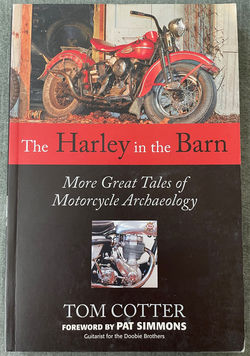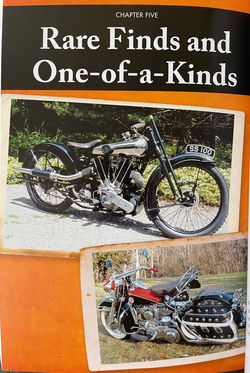THE HARLEY
IN THE BARN MOTORCYCLE ARCHAEOLOGY HARLEY-DAVIDSON INDIAN NORTON BSA
SOFTBOUND BOOK by TOM COTTER
MORE GREAT TALES OF MOTORCYCLE ARCHAEOLOGY
Break into that barn - you know you want to -
there might be a vintage Harley inside. If you won't break in, Tom Cotter will;
amazing motorcycles await.
Driving down a country road, a flash of chrome
catches your eye as you pass an old farmstead. Next time you roll by, you slow
down and focus on a shed behind the house. Could that be? Good lord, it is!
Hard on the brakes, quick reverse, and pull in the drive. Yep, it's a vintage
Triumph Bonneville peering forlornly from beneath a tattered cover. You've just
begun the journey that fuels the dreams of every motorcycle collector: the
long-forgotten machine, rediscovered.
The Harley in the Barn offers forty-plus tales of
lost Nortons, hidden Hondas, dormant Indians, and busted BSAs, all squirreled
away from prying eyes but found by lucky collectors just like you. Author Tom
Cotter is not only a barn-find master, he's also master of discovering the
collectors with the best stories and the most outlandish finds. In The Harley
in the Barn, all those great stories are told.
If you can't pass a padlocked garage without
wondering if there's a great old bike stashed inside, this is your book. Hell,
this is your life.
-------------------------------------------------------------------------------
Additional Information from Internet Encyclopedia
In 1901, 20-year-old William S. Harley drew up
plans for a small engine with a displacement of 7.07 cubic inches (116 cc) and
four-inch (102 mm) flywheels. The engine was designed for use in a regular
pedal-bicycle frame. Over the next two years, Harley and his childhood friend
Arthur Davidson worked on their motor-bicycle using the northside Milwaukee
machine shop at the home of their friend, Henry Melk. It was finished in 1903
with the help of Arthur's brother, Walter Davidson. Upon testing their
power-cycle, Harley and the Davidson brothers found it unable to climb the
hills around Milwaukee without pedal assistance. They quickly wrote off their
first motor-bicycle as a valuable learning experiment.
Work immediately began on a new and improved
second-generation machine. This first "real" Harley-Davidson
motorcycle had a bigger engine of 24.74 cubic inches (405 cc) with 9.75 inches
(25 cm) flywheels weighing 28 lb (13 kg). The machine's advanced loop-frame
pattern was similar to the 1903 Milwaukee Merkel motorcycle (designed by Joseph
Merkel, later of Flying Merkel fame). The bigger engine and loop-frame design
took it out of the motorized bicycle category and marked the path to future
motorcycle designs. The boys also received help with their bigger engine from
outboard motor pioneer Ole Evinrude, who was then building gas engines of his
own design for automotive use on Milwaukee's Lake Street.
The prototype of the new loop-frame
Harley-Davidson was assembled in a 10 ft × 15 ft (3.0 m × 4.6 m) shed in the
Davidson family backyard. Most of the major parts, however, were made
elsewhere, including some probably fabricated at the West Milwaukee railshops
where oldest brother William A. Davidson was then toolroom foreman. This
prototype machine was functional by September 8, 1904, when it competed in a
Milwaukee motorcycle race held at State Fair Park. It was ridden by Edward Hildebrand
and placed fourth. This is the first documented appearance of a Harley-Davidson
motorcycle in the historical record.
In January 1905, small advertisements were placed
in the Automobile and Cycle Trade Journal offering bare Harley-Davidson engines
to the do-it-yourself trade. By April, complete motorcycles were in production
on a very limited basis. That year, the first Harley-Davidson dealer, Carl H.
Lang of Chicago, sold three bikes from the five built in the Davidson backyard
shed. Years later the original shed was taken to the Juneau Avenue factory
where it would stand for many decades as a tribute to the Motor Company's
humble origins until it was accidentally destroyed by contractors cleaning the
factory yard in the early 1970s.
In 1906, Harley and the Davidson brothers built
their first factory on Chestnut Street (later Juneau Avenue), at the current
location of Harley-Davidson's corporate headquarters. The first Juneau Avenue
plant was a 40 ft × 60 ft (12 m × 18 m) single-story wooden structure. The
company produced about 50 motorcycles that year.
Production in 1905 and 1906 were all
single-cylinder models with 26.84 cubic inch (440 cm³) engines. In February
1907 a prototype model with a 45-degree V-Twin engine was displayed at the
Chicago Automobile Show. Although shown and advertised, very few V-Twin models
were built between 1907 and 1910. These first V-Twins displaced 53.68 cubic
inches (880 cm³) and produced about 7 horsepower (5.2 kW). This gave about
double the power of the first singles. Top speed was about 60 mph (100 km/h).
Production jumped from 450 motorcycles in 1908 to 1,149 machines in 1909.
By 1911, some 150 makes of motorcycles had already
been built in the United States – although just a handful would survive the
1910s.
In 1911, an improved V-Twin model was introduced.
The new engine had mechanically operated intake valves, as opposed to the
"automatic" intake valves used on earlier V-Twins that opened by
engine vacuum. With a displacement of 49.48 cubic inches (811 cm³), the 1911
V-Twin was smaller than earlier twins, but gave better performance. After 1913
the majority of bikes produced by Harley-Davidson would be V-Twin models.
In 1912, Harley-Davidson introduced their patented
"Ful-Floteing Seat", which was suspended by a coil spring inside the
seat tube. The spring tension could be adjusted to suit the rider's weight.
More than 3 inches (76 mm) of travel was available. Harley-Davidson would use
seats of this type until 1958.[16]
By 1913, the yellow brick factory had been demolished
and on the site a new 5-story structure had been built. Begun in 1910, the
factory with its many additions would take up two blocks along Juneau Avenue
and around the corner on 38th Street. Despite the competition, Harley-Davidson
was already pulling ahead of Indian and would dominate motorcycle racing after
1914. Production that year swelled to 16,284 machines.
In 1917, the United States entered World War I and
the military demanded motorcycles for the war effort.[17] Harleys had already
been used by the military in the Pancho Villa Expedition[18][19] but World War
I was the first time the motorcycle had been adopted for military issue, first
with the British Model H, produced by British Triumph Motorcycles Ltd in
1915.[20] After the U.S. entry into the war, the U.S. military purchased over
20,000 motorcycles from Harley-Davidson.
By 1920, Harley-Davidson was the largest
motorcycle manufacturer in the world, with 28,189 machines produced, and
dealers in 67 countries.
In 1921, a Harley-Davidson, ridden by Otto Walker,
was the first motorcycle ever to win a race at an average speed greater than
100 mph (160 km/h).
During the 1920s, several improvements were put in
place, such as a new 74 cubic inch (1,212.6
cm³) V-Twin, introduced in 1921, and the "teardrop" gas tank
in 1925. A front brake was added in 1928 although notably only on the J/JD
models.
In the late summer of 1929, Harley-Davidson
introduced its 45 cubic inches (737 cm³) flathead V-Twin to compete with the
Indian 101 Scout and the Excelsior Super X.[28] This was the "D"
model, produced from 1929 to 1931.[29] Riders of Indian motorcycles derisively
referred to this model as the "three cylinder Harley" because the
generator was upright and parallel to the front cylinder.
An 80-cubic-inch (1,300 cm³) flathead engine was
added to the line in 1935, by which time the single-cylinder motorcycles had
been discontinued.
In 1936, the 61E and 61EL models with the
"Knucklehead" OHV engines were introduced.Valvetrain problems in
early Knucklehead engines required a redesign halfway through its first year of
production and retrofitting of the new valvetrain on earlier engines.
By 1937, all Harley-Davidson flathead engines were
equipped with dry-sump oil recirculation systems similar to the one introduced
in the "Knucklehead" OHV engine. The revised 74-cubic-inch (1,212 cc
) V and VL models were renamed U and UL, the 80-cubic-inch (1,300 cc) VH and
VLH to be renamed UH and ULH, and the 45-cubic-inch (740 cc) R to be renamed W.
In 1941, the 74-cubic-inch (1,210 cm³)
"Knucklehead" was introduced as the F and the FL. The 80-cubic-inch
(1,300 cc) flathead UH and ULH models were discontinued after 1941, while the
74 inch (1210 cm³) U & UL flathead models were produced up to 1948.
One of only two American cycle manufacturers to
survive the Great Depression, Harley-Davidson again produced large numbers of
motorcycles for the US Army in World War II and resumed civilian production
afterwards, producing a range of large V-twin motorcycles that were successful
both on racetracks and for private buyers.
Harley-Davidson, on the eve of World War II, was
already supplying the Army with a military-specific version of its 45 cubic
inches (740 cm³) WL line, called the WLA. The A in this case stood for
"Army". Upon the outbreak of war, the company, along with most other
manufacturing enterprises, shifted to war work. More than 90,000 military
motorcycles, mostly WLAs and WLCs (the Canadian version) were produced, many to
be provided to allies. Harley-Davidson received two Army-Navy ‘E’ Awards, one
in 1943 and the other in 1945, which were awarded for Excellence in Production.
Shipments to the Soviet Union under the Lend-Lease
program numbered at least 30,000. The WLAs produced during all four years of
war production generally have 1942 serial numbers. Production of the WLA
stopped at the end of World War II, but was resumed from 1950 to 1952 for use
in the Korean War.
The U.S. Army also asked Harley-Davidson to
produce a new motorcycle with many of the features of BMW's side-valve and
shaft-driven R71. Harley largely copied the BMW engine and drive train and
produced the shaft-driven 750 cc 1942 Harley-Davidson XA. This shared no
dimensions, no parts or no design concepts (except side valves) with any prior
Harley-Davidson engine. Due to the superior cooling of the flat-twin engine
with the cylinders across the frame, Harley's XA cylinder heads ran 100 °F (56
°C) cooler than its V-twins.[39] The XA never entered full production: the
motorcycle by that time had been eclipsed by the Jeep as the Army's general
purpose vehicle, and the WLA—already in production—was sufficient for its
limited police, escort, and courier roles. Only 1,000 were made and the XA
never went into full production. It remains the only shaft-driven Harley-Davidson
ever made.







